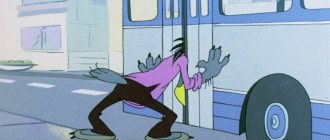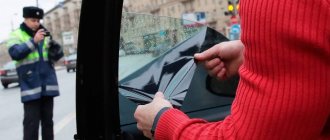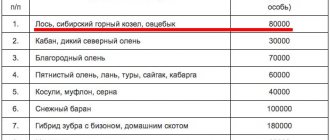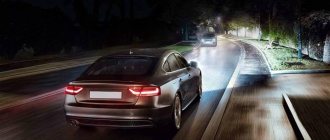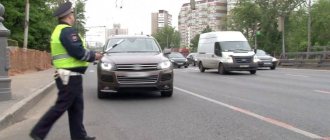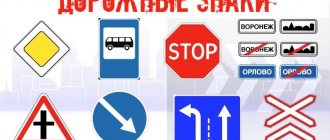Good afternoon, dear reader.
Every driver of a vehicle at least once in his life has found himself in a situation where the opposite side of the roadway was blocked for one reason or another.
The reason for the blockage can be either an unexpected traffic accident or a bus or trolleybus that stops unsuccessfully at a public transport stop. In the described situation, the driver has to make a very difficult choice: whether to wait for the roadway to clear or immediately avoid the obstacle in the oncoming lane of the road.
At the same time, not everyone knows the differences between detour and overtaking, so quite often efficient car owners end up in the hands of traffic police officers, who, on completely legal grounds, deprive them of their driver’s licenses. Or, on not entirely legal grounds, they resolve the issue on the spot.
This article will talk about what avoiding an obstacle and how it differs from overtaking a vehicle:
- What is a detour?
- Where is it prohibited to detour?
- Detour fines.
- Avoiding obstacles in the oncoming lane.
- Avoiding an obstacle through a solid marking line.
What is a detour?
Unfortunately, the current traffic rules do not decipher the concept of detour, so you should refer to Article 12.15 of the Code of Administrative Offenses.
Based on Part 3 of Article 12.15 of the Administrative Code, as well as on the basis of paragraphs 9.2 and 15.3 of the traffic rules, we can conclude that a detour is a kind of maneuver associated with leaving the occupied lane if further movement along the original lane is impossible:
9.2. On dual carriageway roads with four or more lanes, it is prohibited to overtake or pass into the lane intended for oncoming traffic. On such roads, left turns or U-turns may be made at intersections and in other places where this is not prohibited by the Rules, signs and (or) markings.
15.3. It is forbidden to travel to move: ...
- drive around vehicles standing in front of the crossing into oncoming traffic;
Thus, if a vehicle makes a lane change due to the fact that the lane is blocked by something or someone, then its maneuver can be considered as a detour. In all other cases, i.e. if there is some activity in the lane in the form of a moving vehicle, the maneuver can be considered as overtaking or overtaking.
Please note that the penalty for illegal overtaking is more severe than the penalty for illegal passing.
Avoiding a traffic jam through a broken line
- the possibility of performing this maneuver in accordance with signs, rules and markings;
- that the oncoming lane is clear for the intended maneuver;
- that when changing lanes into the oncoming lane or back, no interference will be created for other vehicles.
Overtaking a traffic jam that has accumulated on the roadway is prohibited under any circumstances. Exceptions are vehicles of special services (ambulance, fire department, police, etc.), which are equipped with sound signals and specialized light lights.
Is it possible to go around a traffic jam in oncoming traffic?
The last point was introduced precisely to prevent situations of avoiding traffic jams. Thus, the driver, who has taken the lead and rushed past two hundred cars, risks simply remaining in the oncoming lane if the traffic jammed simply cannot let him back into his lane. And this threatens a head-on collision.
If the oncoming lane is marked with a solid white line, then any overtaking is prohibited and the driver is ordered to push through the traffic jam until it is his turn to pass the traffic light that is slowing everyone down.
But if the oncoming traffic is separated by intermittent markings, then road users may experience unnecessary temptations. After all, the rules do not prohibit crossing a broken line, and the free space hundreds of meters ahead invites you to make a risky maneuver.
Many do just that, creating even more congestion ahead.
What is the fine prescribed in the traffic rules for crossing a solid line marking in the same direction?
According to part one of Article 12.16 of the Administrative Code, driving through a solid line in the same direction without complying with the requirements of road signs or markings, with the exception of cases described in parts 2-7, entails a warning or a fine of 500 rubles.
When turning through a continuous lane in order to change lanes in another direction, from 1000 to 1500 rubles, Art. 12.16, part 2.
When crossing a solid lane and entering a lane with oncoming traffic, the fine will be 5,000 rubles or from 4 to 6 months of deprivation of rights in accordance with Part 4 of Article 12.15 of the Administrative Code.
- Clause 9.1 of Article 9. On any two-way roads, driving in the lane intended for the oncoming direction is prohibited if it is separated by tram tracks, a dividing strip, markings No. 1.1, 1.3, 1.11.
- Clause 9.2 of Article 9. When driving two-way traffic on roads that have four or more lanes, when passing or overtaking, it is prohibited to enter the lane along which oncoming traffic is taking place.
Driving beyond a solid marking line: consequences for traffic regulations in 2019
- It is necessary to explain to the inspector that there was no violation due to the absence of line 1.6 - which means that the driver did not know that he was approaching a continuous line. If the arguments are not taken into account, the inspector must be required to draw up a protocol and diagram describing the violation.
- Next, it is recommended to photograph the place where the line 1.5 changes to 1.1, if possible, capturing in the frame the columns with the numbering of kilometers or other means of identifying the location. Appeal - through the prosecutor's office.
- In the protocol drawn up by the inspector, it is necessary to indicate that “I do not agree with the violation” and briefly give the reasons (that is, the missing “transitional” marking line).
Interesting: Until what time is it legal to make noise?
It was previously noted that in certain cases the decision on guilt for a violation and the existence of an offense in general is made by the court.
This applies to situations where the driver was forced to enter the lane of oncoming traffic.
If the court finds that the actions were truly without alternative, then a fine for driving on a continuous line will not be applied in 2021 (as before) and the administrative process will be terminated. The controversial situations are discussed in more detail below:
Fine for - driving into - oncoming traffic in - 2021 - year
The peculiarity of this situation is that if the road is two-lane, then you can make a left turn or a U-turn on it. As for overtaking, it is prohibited and the penalty for driving into the oncoming lane in this case is very significant, but this will be discussed below.
Interesting: VTB life insurance for mortgages
9.1. The number of lanes for trackless vehicles is determined by markings and (or) signs 5.15.1, 5.15.2, 5.15.7, 5.15.8, and if there are none, then by the drivers themselves, taking into account the width of the roadway, vehicle dimensions and required intervals between them.
In this case, the side intended for oncoming traffic on two-way roads without a dividing strip is considered to be half the width of the roadway located on the left, not counting local widenings of the roadway (transition and express lanes, additional lanes on the rise, drive-in pockets of stops for route vehicles ).
Mazda 3 club (Mazda 3
The situation on a suburban highway, one lane in each direction: an uncontrolled intersection, as you all probably know, overtaking in this case is allowed, but the markings 30-50 meters before and after the intersection are a solid line, and what happens? on the one hand, the traffic rules do not prohibit overtaking, and on the other, having started overtaking directly at the intersection, we cross the continuous road and there is a traffic police station right there and writes it out to us, on completely legal grounds (as some, let’s not point a finger, say here) - 12.15. 4. The logic is ironclad - he crossed a continuous road, drove into oncoming traffic in violation of the rules, and he knows that this maneuver is allowed by the rules. Or we turn left or turn around at this intersection through the same solid road and here you have 12.15.3, because, again, according to some, any left turn and turn is associated with entering oncoming traffic.
The situation on a suburban highway, one lane in each direction: an uncontrolled intersection, as you all probably know, overtaking in this case is allowed, but the markings 30-50 meters before and after the intersection are a solid line, and what happens? on the one hand, the traffic rules do not prohibit overtaking, and on the other, having started overtaking directly at the intersection, we cross the continuous road and there is a traffic police station right there and writes it out to us, on completely legal grounds (as some, let’s not point a finger, say here) - 12.15. 4. The logic is ironclad - he crossed a continuous road, drove into oncoming traffic in violation of the rules, and he knows that this maneuver is allowed by the rules. Or we turn left or turn around at this intersection through the same solid road and here you have 12.15.3, because, again, according to some, any left turn and turn is associated with entering oncoming traffic.
30 Aug 2021 yslygiur 298
Source: https://urist-yslugi.ru/bez-rubriki/obezd-probki-cherez-preryvistuyu-liniyu
Where is it prohibited to detour?
There are only 3 situations in which traffic rules prohibit taking a detour :
- Detour into oncoming traffic on a 4 or more lane road.
- Detour on a 3-lane road with entry to the far left lane.
- Detour into oncoming traffic in front of a railway crossing. I note that detours in front of a railway crossing are prohibited not only on 4-lane roads, but also on roads with 3 or 2 lanes.
In all other situations, detour is permitted . These situations include:
- Detour without entering oncoming traffic.
- A detour into oncoming traffic on a 2-lane road or into the central lane on a 3-lane road, which is not carried out in front of a railway crossing.
In what cases is it possible to drive on the side of the road?
Driving on the side of the road is prohibited for vehicles, especially if it is marked with dividing strips. Departure is legal only for stopping on the right side. In this case, the road can be one-way or two-way, but without tram tracks in the middle.
Who is allowed to drive on the side of the road:
- Special equipment repairing the road.
- Transport of public utilities.
- Trucks that provide transportation of material or goods to sites, if no other access is provided for them.
- Cyclists over 14 years old.
- Mopeds or two-wheeled vehicles at a speed of no more than 20 km/h.
- Horse-drawn carts, pack animals or horses with riders.
It is important to know! In other cases, an attempt to bypass a traffic jam in this way can lead to an accident or create a dangerous situation for a pedestrian. Therefore, violators are punished with a fine or deprivation of rights for up to six months.
The shoulder is an important part of the road, intended for the movement of pedestrians or vehicles, the speed of which, due to technical features, is not capable of exceeding 20 km/h. Driving a car onto it is prohibited; the driver can do this only in special cases. An attempt at unauthorized movement is punishable by administrative liability. In case of repeated similar offenses, the established measure is tightened.
Detour fines in 2021
As noted earlier, traffic rules prohibit a detour only in the case when, during the detour, the car finds itself in the lane of oncoming traffic. Therefore, the punishment for an incorrect detour fits into only one part of Article 12.15 of the Code of Administrative Offences:
3. Driving into a lane intended for oncoming traffic in violation of the Traffic Rules while avoiding an obstacle -
shall entail the imposition of an administrative fine in the amount of one thousand to one thousand five hundred rubles .
Although the fine for improper overtaking is large, its size cannot be compared with the fine for improper overtaking (deprivation of rights for 4-6 months).
Let's consider situations in which questions most often arise regarding the implementation of a detour.
Designation of the roadside in traffic regulations
The shoulder of the highway is not intended for vehicles to travel along it. Cyclists or pedestrians can move freely along it, unless special paths and sidewalks are provided for them. Traveling there unless absolutely necessary or in cases not established by law is strictly prohibited.
It is important to know! According to clause 1.2 of the Russian Traffic Regulations, the concept of “shoulder” is interpreted as the extreme section of the road, highlighted by markings and differing from the other part in the type of coverage or lack thereof. This element is adjacent directly to the path itself and is on the same level as it. The shoulder can be unpaved or reinforced, depending on the terrain and type of terrain.
Its main purpose is as follows:
- Stopping or parking vehicles.
- Turn the car around if it is allowed on this section of the road.
- For passing vehicles moving in the opposite direction on particularly narrow sections of the road.
- To go around an obstacle that has arisen on the way, if it is not possible to do this on the left side.
- For the movement of mopeds and bicycles.
In a car, driving on the side of the road will result in a fine in 2021. Especially if this is done for the purpose of overtaking or avoiding a traffic jam. Why was this sanction introduced? Drivers only increase the danger of the situation on the highway, as due to the raised dust they impair visibility, increase congestion, trying to return to the flow and preventing the normal movement of cyclists or pedestrians.
To reduce the likelihood of an accident as a result of such a violation, the Code of Administrative Offenses provides for administrative liability for such actions in the form of a fine for driving on the side of the road. A traffic police officer can issue it after stopping the vehicle. If during the process the speed limit was not observed and the intersection of solid lanes was recorded, the fines will be cumulative. In some situations, the driver faces deprivation of his license.
Avoiding obstacles in the oncoming lane
The concept of obstacle is given in paragraph 1.2 of the traffic rules:
“Obstacle” is a stationary object in the traffic lane (faulty or damaged vehicle, defect in the roadway, foreign objects, etc.) that does not allow further movement along this lane. A traffic jam or a vehicle stopped in this lane in accordance with the requirements of the Rules is not an obstacle.
So, when a car drives into the oncoming lane, 3 types of punishment may occur for the driver :
No violation
No punishment. In order not to receive a penalty for passing in the oncoming lane, it is necessary to perform this maneuver only on a 2 or 3 lane road, without driving further than the second lane. In addition, it is necessary that there is some kind of obstacle in the passing lane.
An obstacle may be, for example, an open well on the roadway or a traffic accident. However, keep in mind that driving around a bus that has stopped to pick up passengers in the oncoming lane does not mean driving around an obstacle. This maneuver is a detour around a vehicle that is not an obstacle. The punishment for its implementation is discussed below.
Part 3 of Article 12.15 of the Administrative Code
Penalty for incorrect detour (1,000 - 1,500 rubles). Avoiding an obstacle in the oncoming lane is punishable by a fine if the maneuver is performed either on a four-lane road, or on a three-lane road with access to the left lane, or in front of a railway crossing.
It should also be taken into account that an attempt to avoid a traffic jam or traffic jam in the oncoming lane, just as in the case of a bus, will not constitute a detour around the obstacle.
Part 4 of Article 12.15 of the Administrative Code
The penalty for driving around is not an obstacle (deprivation of rights for 4 - 6 months or a fine of 5,000 rubles). A penalty in the form of deprivation of rights may be imposed if a vehicle that is not an obstacle (stopped in accordance with the requirements of the traffic rules) is detoured into the oncoming lane.
Responsibility for driving into oncoming traffic
According to Art. 12.15 of the Administrative Code, a fine for driving into the oncoming lane in 2019 is not the only punishment for the offending driver. After all, this kind of action poses a threat to people’s lives, so sometimes you have to pay for them not only with money. What exactly can a car owner face, in addition to financial penalties, if clause 9.2 of these rules is ignored, we will consider below.
Can my rights be revoked?
As a punishment for ignoring traffic rules when overtaking, Russian legislation is most often limited to drawing up an administrative protocol in the amount of 1,000 to 2,000 rubles. Deprivation of rights usually occurs only under the following circumstances:
- The driver has repeatedly committed an offense under Art. 12.15 of the Code of Administrative Offenses, which is noted in the traffic police database;
- By overtaking a vehicle across a single or double solid line, the motorist has caused an accident;
- A citizen for a long time does not pay the financial penalty issued to him for violating clause 9 of these rules.
Based on this, it turns out that if a driver drives into the oncoming lane for the first time in 2021, he will only face a fine if his maneuver did not cause an accident. But repeated disregard of traffic rules will risk the motorist having his driver’s license seized for a period of 3 to 12 months.
Avoiding an obstacle through a solid marking line
Avoiding an obstacle through a solid line marking 1.1 in any case is a violation of traffic rules. In this case, 3 types of punishment are possible.
Part 1 of Article 12.16 of the Code of Administrative Offenses
A warning or an administrative fine in the amount of 500 rubles, in case of making a detour without entering the lane of oncoming traffic. In this case, it does not matter whether you are driving around an obstacle or a bus that has stopped according to the rules, which is not an obstacle. In any case, a fine will be imposed for failure to comply with road markings.
Part 3 of Article 12.15 of the Administrative Code
A fine of 1,000 - 1,500 rubles can be imposed when driving around an obstacle if you cross a solid marking line separating traffic flows in opposite directions.
For example, this fine may be imposed when avoiding an accident on a two-lane road, in the center of which there is a solid marking line.
Part 4 of Article 12.15 of the Administrative Code
The driver will receive a deprivation of license for 4-6 months (or a fine of 5,000 rubles) if he makes a detour around an obstacle (a bus at a stop), which involves crossing a solid marking line and driving into the oncoming lane.
I hope you were able to understand the different types of penalties for incorrectly performing a detour. Now you have the opportunity to take a detour only if this maneuver does not violate traffic rules. In addition, if you come across a fraudulent traffic police officer who tries to deprive you of your driver’s license for driving around a solid marking line, you will be able to give him a fitting rebuff.
Good luck on the roads!
Conditions for prohibiting entry into the oncoming lane
In total, the traffic rules provide for three main conditions under which a driver will face a fine for driving into the oncoming lane in 2021. Namely:
- Advancing a vehicle through a solid marking line on a highway with 2 or 4 lanes, in the absence of a “Overtaking is allowed” sign;
- Crossing a continuous line dividing a two-way flow under a prohibitory sign 3.20;
- Driving into the oncoming lane on special sections of the road (pedestrian crossing, emergency zone, steep descent/ascent, sharp turn or intersection).
Other options for ahead of transport through a solid marking line will be considered controversial, and the driver will bear responsibility for them only if the traffic police inspector proves his guilt in court.

